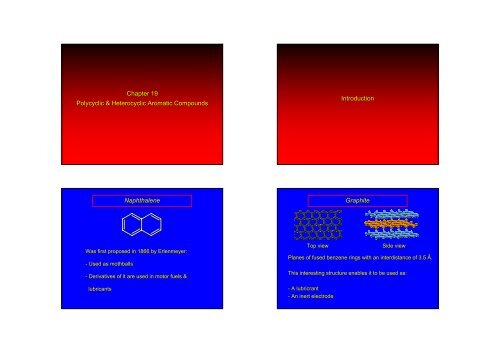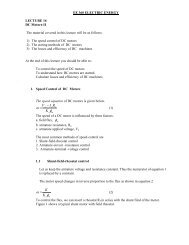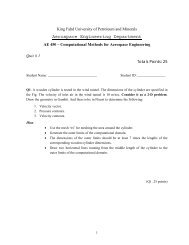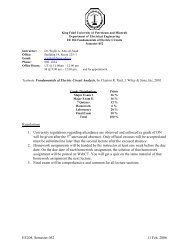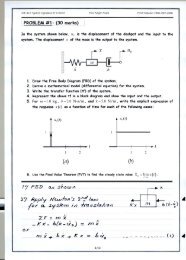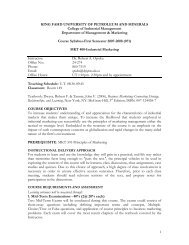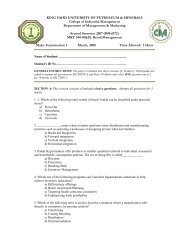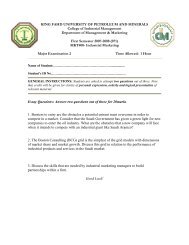Chapter 19 Polycyclic & Heterocyclic Aromatic Compounds ...
Chapter 19 Polycyclic & Heterocyclic Aromatic Compounds ...
Chapter 19 Polycyclic & Heterocyclic Aromatic Compounds ...
Create successful ePaper yourself
Turn your PDF publications into a flip-book with our unique Google optimized e-Paper software.
<strong>Chapter</strong> <strong>19</strong><br />
<strong>Polycyclic</strong> & <strong>Heterocyclic</strong> <strong>Aromatic</strong> <strong>Compounds</strong><br />
Naphthalene<br />
Was first proposed in 1866 by Erlenmeyer:<br />
- Used as mothballs<br />
- Derivatives of it are used in motor fuels &<br />
lubricants<br />
Introduction<br />
Graphite<br />
Top view Side view<br />
Planes of fused benzene rings with an interdistance of 3.5 Ǻ.<br />
This interesting structure enables it to be used as:<br />
- A lubricrant<br />
- An inert electrode
Heterocycles<br />
N<br />
H<br />
Yohimban<br />
A ring having two or more different elements that can<br />
be aromatic.<br />
H<br />
N<br />
H<br />
Nomenclature<br />
- PAHs have individual names<br />
- Numbering is fixed by convention regardless of the position<br />
of the substituent<br />
7<br />
6<br />
8<br />
5<br />
9<br />
10<br />
1<br />
4<br />
2<br />
3<br />
7<br />
6<br />
8<br />
5<br />
1<br />
4<br />
Naphthalene<br />
Anthracene Phenanthrene<br />
2<br />
3<br />
H<br />
3<br />
4<br />
5<br />
6<br />
2 9<br />
1 10<br />
7<br />
8<br />
Nomenclature of PAH<br />
Nomenclature<br />
- Monosubstituted naphthalenes can be designated by Greek<br />
letters too:<br />
b<br />
b<br />
a<br />
a<br />
O O<br />
N<br />
a<br />
a<br />
b<br />
b<br />
1-Nitronaphthalene<br />
Nitronaphthalene 2-Nitronaphthalene<br />
Nitronaphthalene<br />
α-Nitronaphthalene<br />
Nitronaphthalene β-Nitronaphthalene<br />
Nitronaphthalene<br />
7<br />
6<br />
8<br />
5<br />
1<br />
4<br />
2<br />
3<br />
O<br />
N<br />
O
Bonding in PAHs<br />
Resonance energy<br />
Fused aromatics have lower resonance energy than expected<br />
Resonance energy<br />
expected (Kcal/mol): 36<br />
72<br />
Resonance energy<br />
Calculated (Kcal/mol): 36<br />
61<br />
72 108 108<br />
61 84 92<br />
<strong>Aromatic</strong>ity<br />
- Conjugated<br />
- Planar<br />
- Satisfies the Huckel’s Huckel rule (4n+2)<br />
10 π electrons 14 π electrons 14 π electrons<br />
n = 2 n = 3 n = 3<br />
Resonance energy<br />
All carbon bonds in benzene have the same bond length<br />
The carbon bond lengths in naphthalene aren’t aren t all the same:<br />
7<br />
6<br />
8<br />
5<br />
1<br />
4<br />
2<br />
3<br />
Two out of the three resonance structures show C1-C2 C1 C2<br />
double bond
Resonance energy<br />
Phenanthrene shows similar differences among the C9-C10 C9 C10<br />
bond that shows an alkene character:<br />
Br Br<br />
Oxidation<br />
Benzene is difficult to oxidize whereas PAHs are oxidized<br />
more easily but they retain at least one phenyl group to keep<br />
the aromaticity<br />
V 2 O 5 , air, heat<br />
CrO 3 , AcOH<br />
heat<br />
O<br />
O<br />
O<br />
Br<br />
OH<br />
OH<br />
O<br />
1,4-naphthoquinone<br />
Br<br />
- H 2O<br />
O<br />
O<br />
O<br />
Oxidation of PAHs<br />
Reduction of PAHs
Reduction<br />
PAHs can be reduced with sodium and ethanol:<br />
Na, EtOH<br />
Na, EtOH<br />
Na, EtOH<br />
No reaction<br />
tetralin<br />
9,10-dihydroanthracene<br />
EAS of Naphthalenes<br />
Reduction<br />
Hydrogenation of PAHs can be carried out under high T and<br />
Pressure of hydrogen:<br />
+<br />
+<br />
5 H 2<br />
3 H 2<br />
Pt, 35 atm<br />
255 C<br />
Naphthalene<br />
H<br />
1<br />
H<br />
2<br />
H<br />
H H<br />
two sites possible for electrophilic<br />
aromatic substitution<br />
H<br />
Decalin<br />
all other sites at which substitution can occur<br />
are equivalent to 1 and 2<br />
H<br />
H
EAS of Naphthalene<br />
Electrophilic <strong>Aromatic</strong> Substitution reactions of naphthalenes<br />
occur on C-1 C 1 predominantly:<br />
Br<br />
predominantly:<br />
+<br />
Br 2<br />
HNO 3, H2SO4<br />
H 2SO4 conc.<br />
AcCl, AlCl 3<br />
O<br />
NO 2<br />
SO 3H<br />
CCH 3<br />
EAS of Naphthalene<br />
E<br />
H<br />
when attack is at C-2 C<br />
in order for carbocation to be stabilized by allylic<br />
resonance, the benzenoid character of the other<br />
ring is sacrificed<br />
+<br />
E<br />
H<br />
EAS of Naphthalene<br />
E H E H<br />
+<br />
when attack is at C-1 C<br />
carbocation is stabilized by allylic resonance<br />
benzenoid character of other ring is maintained<br />
EAS of naphthalene<br />
Sulfonation reaction of naphthalene is more complex and is T<br />
controlled:<br />
SO3H At 80 C:<br />
At 160 C:<br />
+ SO 3<br />
fast<br />
slow<br />
+<br />
91% Kinetic<br />
15% Thermodynamic<br />
SO 3H<br />
9% Kinetic<br />
85% Thermodynamic
EAS of naphthalene<br />
2-substituted substituted naphthalene is more stable than1-naphthalene<br />
than1 naphthalene<br />
sulfonic acid:<br />
H<br />
H<br />
H<br />
H H<br />
SO 3H<br />
More repulsion<br />
Less stable<br />
H<br />
H<br />
H<br />
H<br />
Nomenclature<br />
H H<br />
H<br />
H<br />
Less Repulsion<br />
More stable<br />
<strong>Aromatic</strong> heterocycles have individual names<br />
5<br />
6<br />
4<br />
N 1<br />
3<br />
2<br />
Pyridine<br />
4<br />
5<br />
S<br />
1<br />
N<br />
3<br />
2<br />
4<br />
5<br />
N<br />
H<br />
1<br />
N<br />
3<br />
2<br />
Thiazole Imidazole<br />
SO 3H<br />
<strong>Aromatic</strong> heterocycles with one heteroatom can be designated<br />
by Greek letters<br />
α<br />
γ<br />
β β<br />
β β<br />
N<br />
Pyridine<br />
α<br />
H<br />
α<br />
N<br />
H<br />
Pyrrole<br />
α<br />
N<br />
Nomenclature of <strong>Aromatic</strong> <strong>Heterocyclic</strong><br />
<strong>Compounds</strong><br />
Some Important <strong>Aromatic</strong> Heterocycles<br />
N<br />
N<br />
H<br />
Pyrrole Furan Thiophene<br />
H<br />
N<br />
N<br />
Pyrimidine Indole<br />
Quinoline Isoquinoline<br />
N<br />
O S<br />
H<br />
N<br />
N<br />
Purine<br />
N<br />
N
Pyridine, a Six-Membered Six Membered <strong>Aromatic</strong><br />
Heterocycle<br />
Pyridine<br />
Pyridine is very unreactive; it resembles<br />
nitrobenzene in its reactivity.<br />
Presence of electronegative atom (N) in ring<br />
causes ππ electrons to be held more strongly than<br />
in benzene.<br />
N<br />
There is none.<br />
Generalization<br />
There are so many different kinds of heterocyclic<br />
aromatic compounds that no generalization<br />
is possible.<br />
Some heterocyclic aromatic compounds<br />
are very reactive toward electrophilic<br />
aromatic substitution, others are very unreactive.<br />
δ +<br />
N δ ¯<br />
Pyridine doesn’t doesn t undergo any Friedel-Crafts Friedel Crafts reaction<br />
(alkylation alkylation, , acylation). acylation).<br />
Pyridine<br />
If reacted with a Lewis Acid<br />
the ring becomes more e-deficient e deficient<br />
Pyridine doesn’t doesn t make any coupling with diazonium salts.<br />
Bromination only proceeds at high T. Substitution occurs at<br />
the 3-position 3 position<br />
δ ++<br />
N +<br />
¯FeBr3 FeBr
N<br />
Pyridine can be sulfonated at high temperature.<br />
EAS takes place at C-3. C 3.<br />
Pyridine<br />
SO 3, , H 2SO SO4 HgSO 4, , 230°C 230<br />
N<br />
71%<br />
SO 3H Like benzene, pyridine resists oxidation reactions<br />
on its ring<br />
N<br />
CH 3<br />
Pyridine<br />
KMnO 4, H 3O +<br />
N<br />
CO 2H<br />
Pyridine<br />
Though it is less basic than alkyl amines, pyridine<br />
undergoes many reactions typical of amines<br />
N<br />
HCl<br />
CH 3 I<br />
N<br />
H Cl -<br />
+<br />
N<br />
CH 3 +<br />
When benzene bears EWG, it undergoes a nucleophilic<br />
substitution reaction on its ring:<br />
O 2 N<br />
Nucleophilic Substitution on Pyridine<br />
NO 2<br />
NO 2<br />
Cl<br />
NH 3<br />
O 2 N<br />
I -<br />
NO 2<br />
NO 2<br />
NH 2
Nucleophilic Substitution on Pyridine<br />
Nitrogen in pyridine withdraws electrons from the ring making<br />
it electron deficient:<br />
N<br />
Loss of H -<br />
NH 3, heat<br />
N Br N NH2 Cl NH 2<br />
NH 3, heat<br />
N N<br />
Substitution occurs at C-2 C 2 and C-4 C 4 but not on C-3 C<br />
NH 2 -<br />
N NH 2<br />
N<br />
H -<br />
Mechanism<br />
H<br />
NH 2<br />
N<br />
N NH<br />
H<br />
NH 2<br />
H 2O<br />
N<br />
H<br />
NH 2<br />
N NH 2<br />
Nucleophilic Substitution on Pyridine<br />
Pyridine can undergo substitution if a very strong base is used:<br />
NH 2 - , heat<br />
-H2 N N<br />
N<br />
+<br />
Li<br />
Heat<br />
NH -<br />
N<br />
H 2O<br />
Quinoline and Isoquinoline<br />
N NH 2
N<br />
7<br />
6<br />
8<br />
5<br />
Nomenclature<br />
N 1<br />
4<br />
2<br />
3<br />
Quinoline Isoquinoline<br />
- Both compounds behave like pyridine<br />
- They are weak bases (pK ( pKb = 9.1 & 8.6)<br />
- They undergo EAS more easily than pyridine but on C-5 C 5 & C-8 C<br />
Nucleophilic Substitution Reactions<br />
Like Pyridine, they undergo substitution if a very strong base<br />
is used:<br />
N<br />
N<br />
1- NH 2 -<br />
2- H 2O<br />
1- CH 3Li<br />
2- H 2O<br />
N<br />
N<br />
CH 3<br />
7<br />
6<br />
N<br />
8<br />
5<br />
NH 2<br />
1<br />
4<br />
N 2<br />
3<br />
N<br />
N<br />
EAS Reactions<br />
HNO 3<br />
H 2SO 4<br />
HNO 3<br />
H 2SO 4<br />
NO 2<br />
NO 2<br />
N<br />
N<br />
NO 2<br />
NO 2<br />
Pyrrole, a Five-Membered Five Membered <strong>Aromatic</strong><br />
Heterocycle<br />
N<br />
N
N<br />
H<br />
Pyrrole, Furan, and Thiophene<br />
••<br />
N<br />
H<br />
••<br />
O<br />
••<br />
••<br />
S<br />
••<br />
Have 1 less ring atom than benzene or<br />
pyridine to hold same number of ππ electrons<br />
(6).<br />
ππ electrons are held less strongly.<br />
These compounds are relatively reactive<br />
toward EAS..<br />
EAS of Pyrrole<br />
O O<br />
BF 3<br />
O<br />
+ CH 3COCCH COCCH3 N CCH<br />
H<br />
75-92% 75 92%<br />
undergoes EAS readily<br />
C-2 2 is most reactive position<br />
CCH 3<br />
Reactions<br />
Unlike pyridine, pyrrole is not basic under usual conditions (pK ( pKb ~ 14)<br />
N<br />
H<br />
N<br />
H<br />
H 3O +<br />
No stable cation<br />
In Pyrrole, the unshared pair of electrons of the<br />
nitrogen atom participate in conjugation which leaves<br />
no more additional electrons to react with a proton<br />
δ +<br />
N δ ¯<br />
δ ¯<br />
••<br />
N<br />
H<br />
Porphyrins<br />
Four pyrrole units joined by =CH- =CH groups<br />
N<br />
H<br />
N N<br />
H<br />
N<br />
Fully aromatic<br />
Important biological unit found in heme, chlorophyll, and in the cytochrome<br />
A metal ion can penetrate inside the macrocycle<br />
δ +
N<br />
N Fe N<br />
N<br />
Porphyrins<br />
HOOC<br />
H 3C<br />
HOOC<br />
H 2C<br />
N<br />
N<br />
Fe<br />
N<br />
Heme<br />
CH 3<br />
CH 3<br />
N<br />
CH 3<br />
CH 2


